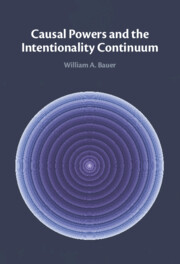Book contents
- Causal Powers and the Intentionality Continuum
- Causal Powers and the Intentionality Continuum
- Copyright page
- Dedication
- Contents
- Figures
- Preface
- Acknowledgments
- Abbreviations
- Introduction
- Part I Why Powers?
- Part II What Are Powers Like?
- Chapter 3 Powers from the Inside
- Chapter 4 A Defense of Physical Intentionality
- Chapter 5 A Defense of Physical Intentionality
- Chapter 6 Powers from the Inside
- Chapter 7 Powers from the Outside
- Chapter 8 Nature’s Intentionality Continuum
- Works Cited
- Index
Chapter 8 - Nature’s Intentionality Continuum
from Part II - What Are Powers Like?
Published online by Cambridge University Press: 13 October 2022
- Causal Powers and the Intentionality Continuum
- Causal Powers and the Intentionality Continuum
- Copyright page
- Dedication
- Contents
- Figures
- Preface
- Acknowledgments
- Abbreviations
- Introduction
- Part I Why Powers?
- Part II What Are Powers Like?
- Chapter 3 Powers from the Inside
- Chapter 4 A Defense of Physical Intentionality
- Chapter 5 A Defense of Physical Intentionality
- Chapter 6 Powers from the Inside
- Chapter 7 Powers from the Outside
- Chapter 8 Nature’s Intentionality Continuum
- Works Cited
- Index
Summary
Building on previous chapters’ conclusions, this chapter posits various organizational levels of intentionality and speculates as to how they interconnect through powers-based processes and biological evolutionary developments. These levels of intentionality form an intentionality continuum. The Intentionality Continuum Thesis holds that intentionality is not a local phenomenon, present only in creatures with minds, but a global phenomenon present in fundamental physical phenomena, biological cells, plants, animals and humans, and human societies. So the continuum of intentionality in nature runs from the physical intentionality of fundamental powers to the complex, higher-level psychological powers of organisms as well as social groups. This might require emergent powers, a possibility that is defended and the account of which is inspired by the fusion theory of emergent properties advanced by Paul Humphreys. Given the panintentionality implied by the Intentionality Continuum Thesis, along with some other defensible assumptions, a reasonable though certainly tentative case can be made for pantheism. The chapter, and the book, conclude by identifying open questions.
Keywords
- Type
- Chapter
- Information
- Causal Powers and the Intentionality Continuum , pp. 185 - 211Publisher: Cambridge University PressPrint publication year: 2022



